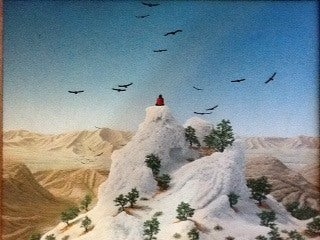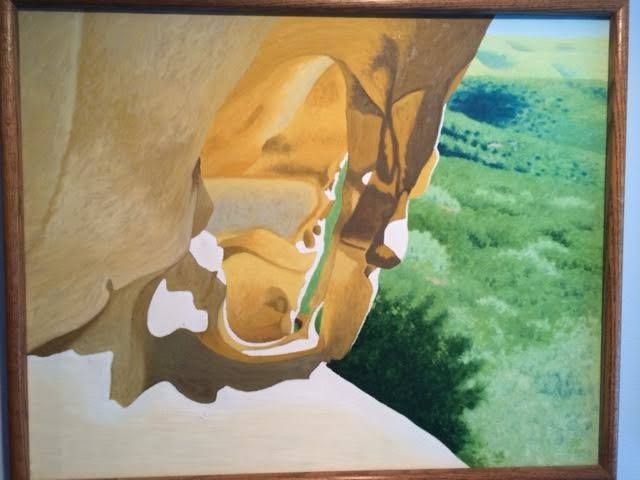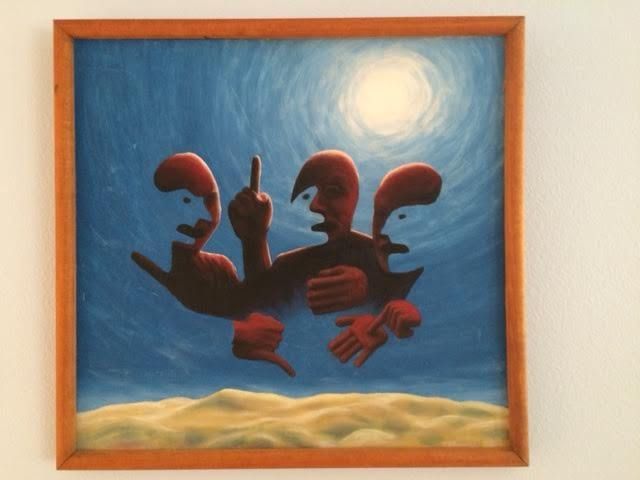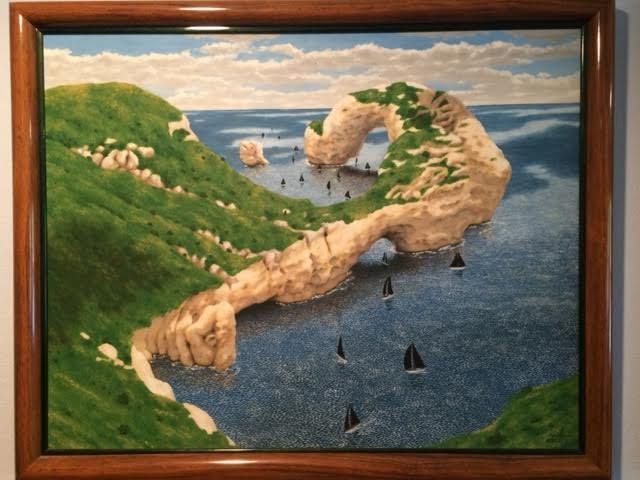Steve Heilig
With R. Kendrick Ferncase

“Moonset”
Most artists create in obscurity. Even many who achieve any notoriety do not attain that until after they are gone. It's sad but true - but then, there are some of true talent who never seek "success" but rather produce only "art for art's sake." This is the personalized story of one.
There's a genre of art known as "outsider", which is described as "art created outside the boundaries of official culture." The often-derogatory term has been applied to work done by self-taught people - who may not even call themselves artists - who don't follow any aesthetic rules, seek to sell their work or appear in galleries, or otherwise do what "career" artists normally do. Dada thus could be seen as at least in part originally an outsider movement, and perhaps street art/graffiti, avant-garde/"free" jazz, much poetry, and many other threads of expression. Occasionally, some such work becomes accepted and even commercially viable--consider the ultimate success of one-time subway/street artists Basquiat and Haring and the shrewd street provocateur Banksy --but most remain very obscure or at most, appreciated by a more cultish following - if at all. Without a knack for self-promotion and networking, the true “outsiders” usually remain in or fade into obscurity.
I am no artistic scholar but in my youth I was for a short but memorable time a good friend with someone who might be called true outsider artist - and not just any hack, but one of undeniable and remarkable talent and skill as a painter. He's long gone and was never really known outside of a small circle of admirers, and this is my small attempt to pay tribute.

“Nothing Place Away from Everything”
Dan Reber was born in the early 1950s in Southern Coastal California, and the small beach town of Corona del Mar was his primary home his entire life. He had at least one older brother who he was not close to when I knew him (a fisherman by trade who later mysteriously disappeared along with his boat off the military testing island San Clemente); his father seemed out of the picture and he lived with his mother on a small one-way street on a canyon that dropped gently to the ocean at a small beach known as Little Corona. When I met him we were both in high school; he was about three years ahead of me.
Dan's "studio" was the basement of the house, but it was a basement with a separate entrance and windows looking out on the canyon and down to the beach. He seemed to almost always be there, painting away at a big drafting table while listening to music and smoking. There was a billiard table, plus some dead plants and random funky furniture. We met via mutual friends and I started visiting frequently as it was only a short walk from my house, and his place was freedom - we could come and go with no contact with adults. This meant that sundry legal or not activities could go on there; it was a cool exclusive bohemian enclave in what was otherwise a beautiful but mostly-conservative Orange County beach town.

“Molecular Jug”
Dan was a non-conformist from the start; he pretty much stopped attending classes during his senior year and dropped out of our high school on graduation day, just to make some point that he didn't need a diploma. From then on he was just a painter and a walker. As cannabis was very much in vogue in our cohort, he enjoyed that too, and would even trade a painting for a "lid" of pot - which then went for about $15. He liked music too - as long as there was no singing - and I traded him some LPs featuring some of the more adventurous groups of the era - the Soft Machine, Frank Zappa, etc - for at least a couple of paintings. Thus there were surreal images and strange music and substances present in his smoky room and at least one friend I brought there found the place far too strange to hang out in for long.
It was an exclusive club by default rather than design, although Dan was a very private person and sometimes would just sit silently at his drafting table while low-key madness enfolded around him. In my last year of high school, his mother moved them to a smaller house not far away, and it was less easy to visit him there but I did so at least a few times, including late at night when he would sit in his upstairs room listening to strange radio broadcasts of storytelling or crackly shortwave transmissions from “Radio Moscow.” He had an "artist" business card printed at that point so he was still providing artwork to at least some people, or at least intended to.
As for his work, he exhibited high technical skill from an early age despite a total lack of formal training (a mutual acquaintance suggested that Dan learned his chops from a ‘50s era “how to draw” television series). His mother pressed him to design their annual holiday card - usually a line drawing of some Christmas-related scene that he likely dashed off in no time - and I think he had some commissions for pieces once in awhile. Rick notes “His occasional figure and portrait renderings were surprisingly naïve--almost amateurish—with a blockish quality reminiscent of pre-Colombian art. His forte was magic realism: highly-realistic scenes from nature, or fantastic visions from his imagination” (some of it inspired by Carlos Castaneda stories popular with stoners back in the day). He seemed to hold intimate knowledge of the natural world; I recall walking on local beach with him when he suddenly reached his hand down into the wet sand and pulled out a squirming octopus - I had noticed nothing.

“Volvox”
After high school, Dan withdrew further, becoming increasingly prolific while adopting a more painterly technique. Rick recalls that "after high school he got into a looser oil painting style rather than the magic photorealism we knew him for around 1972. In the '70s and '80s he fixated on a particular rock formation in the Laguna Hills that he called ’Surrealistic Sandstone,’ painting hundreds of versions with only slight variations. From time to time, after amassing more paintings than he could store, he would haul them out to the street on trash collection day and watch the Masonite panels be crushed in the jaws of the trash truck compacter. Another time, he sold his entire collection of work up to that time to a friend for a mere $500.”
In retrospect, this obsessive repetitive painting behavior possibly signaled the mental illness that would derail his life. From my knowledge in the arena, it would seem he became schizophrenic, the disease manifesting itself in his early to mid-twenties, as is most common in men with the disorder. His heavy use of tobacco, marijuana, and other drugs, including some psychedelics (Rick notes that after reading about the psychoactive properties of Jimson weed, Dan set to collecting, mashing, and distilling an evil-smelling black tar from the plant that even he couldn’t bring himself to sample), might have also been both self-medication and contributor to his becoming symptomatic. In any event, it was progressive and severe, and very sad, eventually reducing him to a barely audible, mumbling shadow of his former self.

“Surrealistic Sandstone”
At one point he left our town, putting whatever he could into his small car, an Opel Kadet, and moving to the then almost-ghost town of Jerome, Arizona. Built on the side of a mountain in the 1800s, Jerome's mining economy had long collapsed but it was yet to become a tourist destination. When I took off to visit friends in New Mexico, I decided to go via Jerome and visit Dan. I only knew that he was there, somewhere, and when I drove down the winding single road, there was nobody around and no addresses on the abandoned buildings. A sign before the tiny "library" read "Open the first Saturday of each month." At the one store, I asked the fellow working there if he knew Dan, and tried to describe him. "Hmm, I might know who you mean; go back up the road and he is in one of the buildings on the left, not sure which." So I drove the short way back up and looked around until I saw his car. I parked and wandered around a building, calling his name, and out he came. His head was shaved and burnt very dark by the high desert sun. His eyes were both glazed and piercing. He was even skinnier than before. He seemed happy to see me.
He led me into his place, which consisted of a couple unfurnished rooms in a dilapidated building, overlooking a big valley. I don't recall if he had electricity; perhaps he was squatting in an abandoned place. We talked and as it got late, it occurred to me that he seemed to have no food, and he confirmed that. So I drove back down to the shop and bought some groceries, returned, and we ate cereal. At some point I asked how his painting was going and he said he had many and motioned to a pile leaning against the wall; I went over to look and, leafing through them, saw that they were all of the same rocky cave scene. Later, seeing the famous Kubrick film "The Shining," I was reminded of my discomfort with this discovery by the scene when Jack Nicholson's character's "novel" is revealed to be the line "All work and no play makes Jack a dull boy" typed over and over.

“Late, but very well painted” - high school teacher’s note on back of this untitled piece.
I traveled on the next day; that was my last real interaction with Dan. He moved back to our hometown; Rick recalls "His usual haunt was one of two Coco’s diners in CdM (both now gone), but the last time I saw him was in front of the post office, where someone came up as we were “talking” (more like trying to understand his barely audible ramblings) and put a $20 dollar bill in his hand." I heard he surprised people by showing up for an informal outdoors ten-year "reunion" of his few friends and, when asked where he lived, sat down on the ground and simply replied "Right here." He also reportedly had become institutionalized at some point or points. His mother died and he seemed to then be truly on his own. Mostly he was just seen walking around town, an accepted "street person" who was tolerated as a harmless native, known to some as 'the wanderer." I tried to talk with him one more time, when I encountered him on the sidewalk over the beach; I was not sure he recognized me when I reintroduced myself, and he just stared at me and said "Words upon words upon words....". It was very disturbing and I moved on, sadly knowing I would not attempt to speak with him again.

“Argument”
There is nothing at all about Dan online, as his life and demise predates the internet. Searches turn up another very different artist with considerably more business sense than our Dan. Via Facebook, however, I had a brief exchange with somebody who knew him when even younger than I had, and who had heard he had died years ago. But that’s it. "There's a lot of mythology floating around about Dan," says Rick. "Mostly that he was killed by a car as he was walking somewhere in CdM - in front of the Five Crowns (a famed longtime restaurant on the coast highway). Somebody else told me that that Dan broke into somebody's house and was arrested but I suspect that is apocryphal as well. I haven't seen him since 1999 and I miss him very much."

“Black Sails”
So do I - really. And thus this little tribute.

